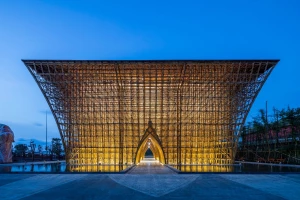In September 2023, Casa da Arquitectura – Centro Português de Arquitectura (Portuguese Centre for Architecture) in Porto hosted the second edition of “Build - From High to Low Tech”. This international conference aims to challenge prevailing perspectives and thinking around the use of materials and technology in architecture. Its remit is based on the World Green Building Council’s assertion that “buildings are currently responsible for 39% of global energy related carbon emissions.”
During the Build conference, Milan-based architecture, interior design, and urban planning studio Park Associati organized a two-day “Hempcrete Workshop” in collaboration with Natura Matéria (a consultant in sustainable construction and “spin-off” brand of the University of Minho). The workshop explored hempcrete’s potential to provide an innovative low-tech bio-based material solution for use in future construction. Participants used hempcrete blocks to create “Tatu”, a small outdoor pavilion designed by Park Associati.
The pavilion’s design was inspired by the ancient giardino Pantesco (Pantellerian garden), a circular garden hailing from the small Italian island of Pantelleria that creates its own microclimate, protecting a single sapling. Park Associati explains: “Tatu took the form of a semi-circle made from hemp bricks, protecting a single plant to symbolize our natural biosphere.” The studio’s Park Plus team and Design Technology group worked on the project’s concept, part of which demonstrated how a parametric approach could make low-tech construction more efficient. “We had to work quickly and precisely, so we used CNC milling to create a specific parametric wooden tool that guided the construction process,” explains Park Associati. “This tool ensured that even though our approach was low-tech, the progressive rotation of the blocks achieved the desired armadillo skin effect envisioned by the designers.” (“Tatu” is the Portuguese word for armadillo, hence the project’s name.)
Hempcrete is a composite of hemp's shiv (woody core) and a lime binder. “With regard to reducing environmental impact, recent studies show that hemp shavings, hempcrete’s raw material, have a very similar performance to wood — such a pine wood — in terms of CO2 consumption per hectare,” says César Cardoso of Natura Matéria. “Other studies have shown that even after the hempcrete blocks are produced, despite the impact of their preparation and transportation, there is still a negative impact on CO2.”
A bio-based material such as hempcrete has the potential to replace traditional building materials. “Tatu is a practical example of how bio-based materials can shape the future of architecture,” says Park Associati. “It is a nod to environmentally-friendly choices and how they can reduce the impact of construction on our planet.” Facilitating a transition away from fossil fuels, bio-based materials have a number of advantages, including their sustainable production, low-carbon footprint, recyclability, flexibility, and thermal insulation properties.
Designed to be quickly assembled and disassembled, the temporary Tatu pavilion’s hempcrete blocks were shipped to the construction site of a private villa outside Porto.
Video: “Hempcrete Workshop” in Porto by Park Associati































































